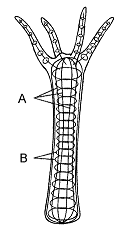Contraction of the fibers labeled A in the accompanying figure results in:

a. elongation of the body.
b. elongation of the tentacles.
c. elongation of the gastrovascular cavity.
d. shortening of the body.
e. expansion of the pedal disk.
d
You might also like to view...
When the diaphragm contracts, it moves up into the thoracic cavity, thereby decreasing its volume
Indicate whether the statement is true or false.
Which molecule is incorrectly matched with its monomer?
A. Fat; fatty acid B. Starch; fructose C. Protein; amino acid D. Cellulose; glucose E. Nucleic acids; nucleotide
The thermal death point of a strain of Stapylcococcus aureus was determined to be 63°C. How would the the thermal death point of Bacillus subtilis compare?
A. The thermal death point of Bacillus subtilis would be significantly higher than that of Staphylococcus aureus. B. The thermal death point of Bacillus subtilis would be just slightly higher than that of Staphylococcus aureus. C. The thermal death point of Bacillus subtilis would be lower that of Staphylococcus aureus. D. The thermal death point of Bacillus subtilis would be the same as that of Staphylococcus aureus.
Following their respective breeding seasons, several species of hummingbirds occur at the same locations in North America and several hummingbird flowers bloom simultaneously in these habitats. These flowers seem to have converged to a common morphology and color. Birds are most visually sensitive to the color red. Hummingbird flowers are pollinated by hummingbirds. Which of the following features of these flowers would indicate they have coevolved with hummingbirds? (Check all that apply.)A) Long tubular flowersB) Flowers are colored violet and blueC) Blooming time of the flowers coincides with the arrival of the hummingbirdsD) Flowers produce a high volume of nectar and sugarE) Flowers are low to the ground
What will be an ideal response?